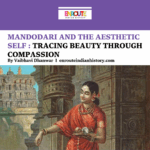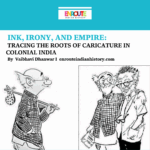By Vaibhavi Danwar
In Goa’s colorful alleys, an intriguing alchemy is brewing. It sizzles in kilns, takes shape in streamlined curves, and tells stories glazed in ochre and indigo. No grandmother’s pottery. Here are the new-generation studio potters urban revivalists who merge traditional skills with global flair, style, and brains. But beneath the beauty of handmade ceramics lies a simmering tension: Are the urban potters cultural heroes or trendy appropriators? Tracing the Azulejos pottery fire project in Goa, this paper explores how urban studio pottery movements negotiate tradition, globalization, and identity. We walk through tiles, tensions, and transnational influences, diving into a kaleidoscopic world where clay is a cultural battleground.
Tradition reimagined in cosmopolitan clay.
Urban potters now aren’t just restoring old traditions ,they’re remixing them, creating a cultural exchange that’s as international as it is local. They work within cosmopolitan spaces, frequently moulded by global residencies, international biennales, and social media like Instagram. Their design preferences appeal less to ethnographic truth and more to the algorithmic eye of a globalised art world. What results is a hybrid form of cultural production that navigates between rooted histories and floating aesthetics.
This phenomenon closely aligns with Koichi Iwabuchi’s (2002) concept of “cultural odorlessness”, where cultural products are deliberately decontextualized or stripped of specific markers of origin to enhance their global marketability. Iwabuchi originally applied this idea to Japanese consumer goods, but its implications extend well into the realm of global art and craft. In studio ceramics, we see this odorlessness where, for example, a Goan potter uses Japanese raku firing techniques or Moroccan glaze motifs without calling upon their cultural or historical origins. The beauty here is not in fidelity to tradition but in a select cosmopolitanism that addresses a global audience well-conditioned to value from above context. Scholars like Marsha Meskimmon (2010) contend that modern craft is increasingly influenced by “transnational imagination,” whereby artists borrow from a wide range of cultural references, not to appropriate, but to reimagine and reconnect creative genealogies. Under this perspective, the hybrid aesthetics of urban potters are less about erasing origin than re-signifying it within a wider global conversation.
The azulejos pottery kiln in Goa is a living testament to this cultural fluidity. Inspired by Portuguese azulejos, the famous ceramic tiles that used to cover Iberian palaces and churches, this studio blends colonial design themes with Goan clay and Indian storytelling styles. The outcome is visually striking work that calls up Lisbon’s tiled facades and Konkan folktales. As art historian Mala Chandrashekhar observes in her study of Goan azulejos, the tiles are already complexly layered with colonialism, having been brought to India via imperial circuits of taste and power. Modern potters in Goa, therefore, are not simply carrying on a tradition; they are re-glazing it with fresh meanings, juggling homage with reinvention. Urban ceramics in the present, particularly in postcolonial situations such as India, show us how craft may be an arena of aesthetic negotiation, between past and present, between local identity and global style. Not static objects, these pieces become “contact zones” (borrowing Mary Louise Pratt’s phrase), where histories crash, overlap, and are rearticulated in material form. In a global world more and more dominated by cross-cultural flows, contemporary studio pottery is not so much a revival as a remix, fried to perfection in the kiln of worldwide modernity.
NGOs, Craft Revival, and the Paradox of Cultural Empowerment
The involvement of non-governmental organizations (NGOs) in reviving moribund crafts adds a critical, multifaceted element to the discussion of heritage and development. Over the past few decades, various NGOs have functioned as mediators between rural artisans and international markets, providing infrastructural facilities, design input, and connections to fair-trade networks. Such interventions tend to look empowering at first glance facilitating artisans to maintain livelihoods and conserve cultural knowledge. But the story is more complicated. Scholars like Amita Baviskar (2003) have criticized such development stories for warning against NGOs’ tendency to commodify and aestheticize local traditions. Crafts are often decontextualized and repackaged in the name of ‘revival’ for elite, and often international, consumption, converting living traditions into boutique spectacles.
The Azulias pottery fire in Goa is a rich case study. This event brought together urban designers, local artisans, and design-and-craft NGOs in a bid to revamp a previously waning tradition. The outcomes were aesthetically pleasing and technically groundbreaking. However, beneath the veneer of success were caustic questions: Who really stands to gain from these revival projects? Are artisans enabled as powerful co-creators, or are they quietly re-hyped as labourers in an artful supply chain managed by designers and NGOs?
NGOs therefore tread a delicate tightrope. On the one hand, they are critical mediators that serve to connect the dots between traditional knowledge frameworks and globalized requirements. Conversely, they are at risk of unintentionally remaking artisans passive actors in a neoliberal script for development. Equilibrium between reinvention and revival, spectacle and sustainability, continues to be fragile and tenuous. If artisans lack significant autonomy over design activity, decision-making, and the terms of profit-sharing, the craft revival would not be one of revival at all but perhaps a reinvention in someone else’s name. In the end, success for such interventions will have to be gauged not simply by the aesthetic beauty of the products or the surprise of collaborations, but by the degree to which they revive dignity, agency, and continuity for artisan communities. As Baviskar reminds us, “culture” in development is not a resource to be extracted, but a lifeworld to be inhabited.
Ethical Innovation in Contemporary Craft
At the center of the modern craft revival is a complicated and frequently contentious argument. When city potters in urban workshops take up old techniques, whether it’s Rajasthan’s earthy glazes or Northeast India’s coiling techniques, are they bringing to life a moribund heritage, or cherry-picking it for aesthetic capital? This query resonates a larger tension of global cultural flows, particularly around power and the politics of representation. Cultural appropriation critics are right to point to the asymmetries that underlie such exchanges: while urban potters get their products advertised in fancy lifestyle magazines and art fairs, the rural artisans upon whom they draw ancestral knowledge all too often remain uncredited, kept out of both visibility and remunerations. But there are encouraging countercurrents. New collaborative models are rethinking the balance between innovation and tradition, indicating that heritage can be reinstated ethically, if it is co-created, not consumed. Ethical collaboration is not only the application of indigenous methods, but the interaction with artisans as creative partners who contribute their own stories and visions to the design process. In this framework, the artisan is not a skilled hand but a co-author of cultural meaning.
Koichi Iwabuchi’s notion of “decentered globalization” is particularly instructive in this context. One such model for this type of collaboration is found in initiatives such as Azulias, a modern ceramics cooperative that involves urban designers with traditional potters. What distinguishes Azulias is its dedication to equity: rural potters are not wage laborers but designers, storytellers, and sharers of profit. Their experiences, symbolic universes, and haptic knowledge become the focus of the creative process. In this case, the revival of craft is a collaboration, a story written by multiple hands.It recalls each imprint, each pressure, each gesture. And by doing this, it encourages us to imagine the possibility of a future where tradition and innovation need not clash, but rather engage in conversation, held together by respect, reciprocity, and shared creativity.
Studio pottery in Goa is more than revival, it’s a reinvention shaped by cross-cultural flows and ethical dilemmas. Projects like Azulejos show how tradition can be both honored and transformed when artisans are treated as creative equals. Hence True revival, this paper argued, lies not in replication but in respectful reinvention, where past and present co-create, and every pot tells a story of belonging, not just beauty.
References
(Baviskar, A. 2006) “Cultural Politics of Environment and Development: The Indian Experience.” Review of Development and Change 11.1: 1–14. Web.
(Iwabuchi, K. 2002). Recentering Globalization: Popular Culture and Japanese Transnationalism. Duke University Press.
(Chandrashekhar, M. 2024) Azulejos Tiles of Goa: The Portuguese Influence on cultural heritage of India
















